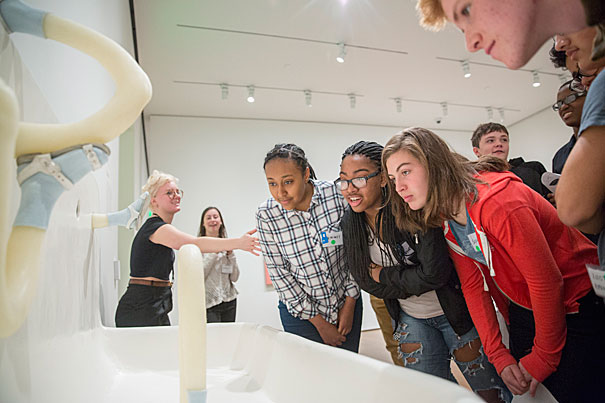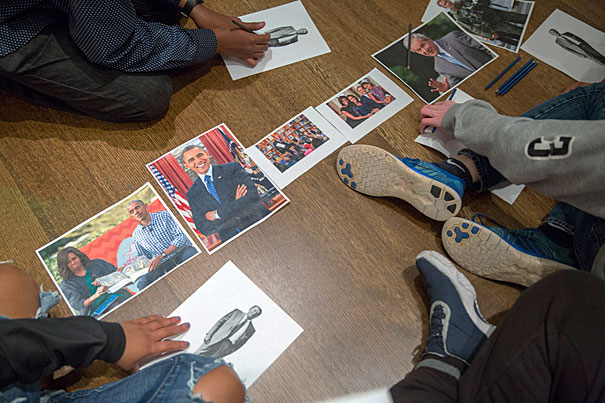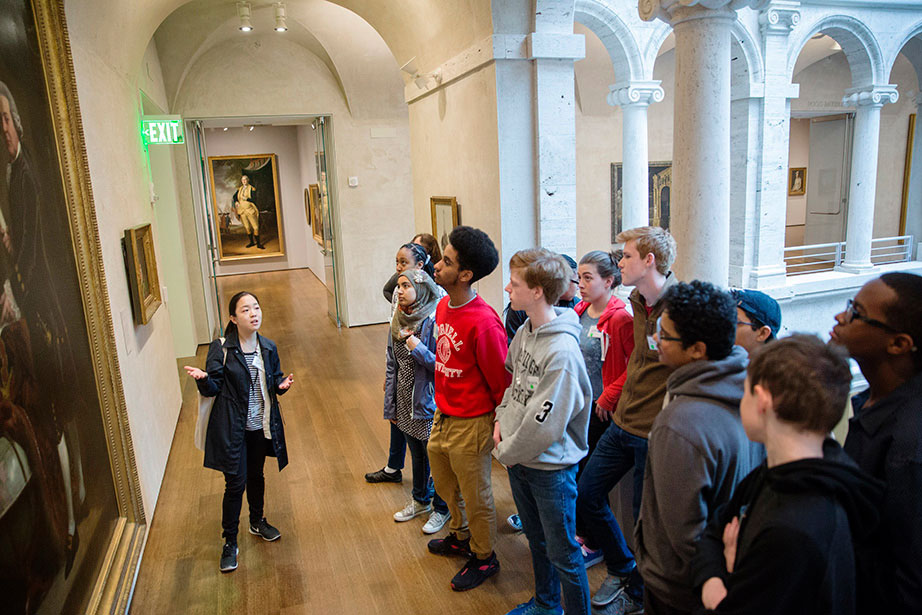
Graduate student teacher Rosie Busiakiewicz (from left, photo 1) engages in a discussion with Beminet Desalegn, Danielle Reeves, Sophie Harrington, and other CRLS students during a visit to the Harvard Art Museums.
Kris Snibbe/Harvard Staff Photographer
The link between art and history
Students, teachers, and student teachers make the connection at the Harvard Art Museums
Cambridge Rindge and Latin (CRLS) students are building a special connection to the Harvard Art Museums with the museums’ Graduate Student Teacher program, which the students say has changed the way they experience art and history.
“In history class, we usually look at the pictures and talk about the context, but here we get to really experience it,” said Beminet Desalegn, whose Advanced Placement (AP) U.S. history class recently visited the museums to study images of presidents and the history of African-American oppression in the U.S. “You get to make up your own mind about these events.”
AP history student Nusrat Jahan agreed: “It’s not very interesting to just read about past events. But when you come here and see the art made by people actually living in that time, when you think about it and talk about it or even re-create a work by drawing it, you get a more in-depth understanding of that time and what people were going through. We get to see the context, and really experience it ourselves.”
The partnership program brings about 120 students into the Harvard Art Museums each semester. Harvard Graduate School of Education (HGSE) student teachers work with CRLS teachers to design and teach classes that incorporate the museums’ art with classroom curriculum.
“We create tours that connect back to what they’re learning in class,” said HGSE student teacher Jessica Paik. “We encourage them to make connections between the work of art and the concepts they’re studying — to make those connections analytically. It’s very helpful to master that skill. Just knowing the facts is not enough: History is not just facts; it’s a story. It has a lot to do with our perspectives and our analysis.”
AP U.S. history teacher Marlin Kann, who is in his first year with the partnership program, said the program “has really increased the sophistication of the students’ understanding of history. They not only look forward to it as a wonderful event, but it’s raised their understanding of what history is.”


Students examine materials from different eras of American history. Jessica Paik, a student at HGSE, talks to students about John Singleton Copley’s portrait of U.S. President John Adams.
Kris Snibbe/Harvard Staff Photographer
As an example, Kann recalled the students examining art works collectively titled “Medals of Dishonor,” featuring several cast-metal narrative reliefs made by American artist David Smith in the 1930s. Funded by the federal government’s New Deal program, each item bears a unique anti-war theme.
“The medals also speak to the rise of fascism, using medicine as a weapon, civilian bombings, and so on,” he said. “They’re not only connected to history, but the context is also within the prism of the 1930s. It helps make these things very real to the students, and it challenges you to analyze images as an historian, rather than solely as an artistic audience.”
“School visits to museums can feel like field trips, but our student teachers are trying to create real-world connections,” said David Odo, the museums’ director of student programs and research curator for University collections initiatives, who oversees the program. “We want to help CRLS teachers reach the high goals they have set for themselves and their students, and we want to give the students a strong entry point to challenge their assumptions about the world. Harvard Art Museums is a place for these students to think, and grow — and belong.”



